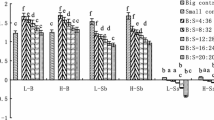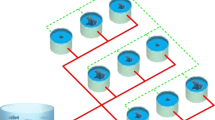Abstract
Intensive and semi-intensive sea cucumber aquaculture produces effluents that impact the quality of the local aquatic environment and sea cucumber growth; such effluents are an important cause of coastal water eutrophication. Integrated aquaculture has been shown to efficiently reduce the release of nutrients during aquaculture and to provide economic benefits. In this study, we report our investigation of a polyculture system utilizing Styela clava (stalked sea squirt) and Stichopus japonicus (Japanese sea cucumber) under two feeding modes. To examine purification of the water in the system, nutrients in the water and the sediment, attached heterotrophic bacteria, and the survival rates and growth rates of S. clava and S. japonicus were determined. Tank cultivation trials showed that, under the same feeding modes, the concentration of nutrients in the polyculture system was approximately 50–60 % of the sum of the nutrients in the S. japonicus mixture and S. clava monoculture systems. The abundance of attached heterotrophic bacteria in the polyculture system was remarkably lower than that of the mixed culture system under the same feeding mode. S. japonicus in the polyculture system grew better than those in the mixed culture system under the same feeding mode. These results demonstrate that the S. clava–S. japonicus integrated culture system offers a means of constraining or reversing the pollutive impacts of coastal sea cucumber aquaculture.



Similar content being viewed by others
References
908 special office of State Oceanic Administration People’s Republic of China (2006) Criterion of ocean investigation. China Ocean Press, Beijing
Asha PS, Muthiah P (2006) Effects of single and combined microalgae on larval growth, development and survival of the commercial sea cucumber Holothuria spinifera Theel. Aquac Res 37:113–118
Bao J, Lihong C, Ronglian X, Aili J (2015) A new integrated multi-trophic aquaculture system consisting of Styela clava, microalgae, and Stichopus japonicus. Aquac Int 23:471–497
Bosma RH, Verdegem MCJ (2011) Sustainable aquaculture in ponds: principles, practices and limits. Livest Sci 139(1–2):58–68
Braaten B (1992) Impact of pollution from aquaculture in six Nordic countries, release of nutrient, effect, and wastewater treatment. Aquac Environ 16:79–101
Briggs MRP, Funge S (1998) Nutrient budgets in intensive shrimp ponds: implication for sustainability. Aquaculture 164(1):117–133
Chen J (2003) Overview of sea cucumber farming and sea ranching practices in China. Inf Bull 18:18–23
Chen J (2004) Present status and prospects of sea cucumber industry in China, FAO Fisheries Technical Paper, Rome, 26
Chopin T, Robinson SMC, Troell M et al (2008) Ecological engineering: multi-trophic integration for sustainable marine aquaculture. In: Jorgensen SE, Fath B (eds) The encyclopedia of ecology, vol 3. Elsevier, Oxford, pp 2463–2475
Cloern JE (2001) Our evolving conceptual model of the coastal eutrophication problem. Mar Ecol Prog Ser 210:223–253
Evans F, Langdon CJ (2000) Co-culture of dulse Palmaria mollis and red abalone Haliotis rufescens under limited flow conditions. Aquaculture 185:137–158
Fan HZ (2001) Research and development on the functional component of Sea cucumber: Panax in the sea. Mar Drug China 4:37–44 (in Chinese)
Friedl G, Dinkel C, Welhrli B (1998) Benthic flues of nutrients in the northwestern Black Sea. Mar Chem 62:77–88
Green BW, Boyd C (1995) Chemical budgets for organically fertilized fish ponds in the dry tropics. J World Aquac Soc 26(3):284–296
Gu QQ, Zu CL, Fang YC (2000) Research on chemical component of Styela Clava. Mar Drug China 1:4–7 (in Chinese)
Hamel J-F, Hidalgo RY, Mercier A (2003) Larval development and juvenile growth of the Galapagos sea cucumber Isostichopus fuscus. Beche-de-mer Inf Bull 18:3–8
Jangous M, Rasolofonirina R, Vaitilingon D et al (2001) A sea cucumber hatchery and mariculture project in Tulear, Madagascar. Beche-de-mer Inf Bull 14:2–6
Jeff K (2002) Overview of the beche-de-mer fishery in Milne Bay Province, Papua New Guinea. Beche-de-mer Inf Bull 17:2–6
Jiang HX, Zheng Y (2002) Antimicrobial activities of 8 species of microalgae. J Fujian Norm Univ (Nat Sci) 18(2):117–120
Jiang AL, Lin J, Wang CH (2008) Physiological energetics of the ascidian Styela clava in relation to body size and temperature. Comp Biochem Physiol Part A: Mol Integr Physiol 149(2):129–136
Jim JS, Chen JX (2001) Sea farming and sea ranching in China. FAO Fisheries Technical Paper 418. Rome, pp 43–46
Jones AB, Dennison WC, Preston NP (2001) Integrated treatment of shrimp effluent by sedimentation, oyster filtration and macroalgal absorption: a laboratory scale study. Aquaculture 193:155–178
Macdonald BA, Ward JE (1994) Variation in food quality and particle selectivity in the sea scallop Placopecten mogellanieuv. Mar Ecol Prog Ser 1118:251–264
McCarron E, Bumell G, Mouzakitis G (2009) Growth assessment on three size classes of the purple sea urchin Paracentrotus lividus using continuous and intermittent feeding regions. Aquaculture 288:83–91
Neori A, Krom MD, Ellner SP et al (1996) Sea weed biofilters as regulators of water quality in integrated fish-seaweed culture units. Aquaculture 141:183–194
Paltzat DL, Pearce CM, Barnes PA, Mckinley RS (2008) Growth and production of California sea cucumber (Parastichopus californicus Stimpson) co-cultured with suspended Pacific oysters(Crassostrea gigas Thunberg). Aquaculture 275:124–137
Popov AM (2002) Comparative study of cytotoxic and hemolytic effects of triterpenoids isolated from Ginseng and Sea cucumber. Izvestila Akademli Nauk. Seriia Biologieheskaia/Rossiiskais Akademiia Nauk 29:155–164
Purcell SW, Patrois J, Fraisse N (2006) Experimental evaluation of co-culture of juvenile sea cucumbers, Holothuria scabra(Jaeger), with juvenile blue shrimp, Litopenaeus stylirostris (Stimpson). Aquaculture Research 37:515–522
Ribes M, Coma R, Atkinson MJ, Kinzie RA (2005) Sponges and ascidians control removal of particulate organic nitrogen from coral reef water. Limnol Oceanogr 50(5):1480–1489
Shiell GR, Knott B (2008) Diurnal observations of sheltering behavior in the coral reef sea cucumber Holothuria whitmaei. Fish Res 91:112–117
Shnel N, Barak Y, Ezer T et al (2002) Design and performance of a zero-discharge tilapia system. Aquac Eng 26:191–203
Soto K (2009) Integrated mariculture: a global review. FAO Fisheries and Aquaculture Technical Paper, FAO, Rome, p 183
Vadas RL, Beal B, Dowling T, Fegley JC (2000) Experimental field tests of natural algal diets on gonad index and quality in the green sea urchin, Strongylocentrotus droebachiensis: a case for rapid summer production in post-spawned animals. Aquaculture 182(1–2):115–135
Wang JQ, Cheng X, Yang Y, Wang N (2007a) Polyculture of juvenile sea urchin (Strongylocen trotus intermedius) (Apistichopus japonicus Selenka) at various stocking densities. J Dalian Fish Univ 22:102–108
Wang JQ, Yang Y, Cheng X, Zhang JC (2007b) Polyculture of Haliotis discus hannai with Apostichopus japonicus Selenka at various stocking densities. Fish Inf 4:12–21 (in Chinese)
Yang H, Yuan X, Zhou Y et al (2005) Effects of body size and water temperature on food consumption and growth in the sea cucumber Apostichopus japonicus (Selenka) with special reference to aestivation. Aquac Res 36:1058–1092
Zhou Y, Yang H, Liu S, Yuan X, Mao Y, Liu Y, Xu X, Zhang F (2006) Feeding and growth on bivalve biodeposits by the deposit feeder Stichopus japonicus Selenka (Echinodermata: Holothuroidea) co-cultured in lantern nets. Aquaculture 256:510–520
Acknowledgments
This study was funded by the National Natural Science Fund Committee of China (Grants 31001113 and 31070368) and the National Natural Science Foundation of Shandong Province (BS2010HZ022, ZR2014CM031).
Author information
Authors and Affiliations
Corresponding author
Rights and permissions
About this article
Cite this article
Chen, Lh., Xing, Rl., Jiang, Al. et al. A preliminary study on the potential value of a novel integrated aquaculture system on water purification. Aquacult Int 24, 879–892 (2016). https://doi.org/10.1007/s10499-015-9958-8
Received:
Accepted:
Published:
Issue Date:
DOI: https://doi.org/10.1007/s10499-015-9958-8




